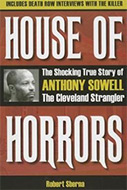House of Horrors: The Shocking True Story of Anthony Sowell, the Cleveland Strangler

Author: Robert Sberna
Publisher: Kent, OH: Black Squirrel Books, 2012. 216p
Reviewer: Jessica Schmidt | November 2013
In America, horrendous unbelievable crimes quickly make national news, and almost instantaneously the people who commit these crimes become infamous. For criminal justice and criminology scholars, these crimes, their victims, and the people who perpetrate them offer an opportunity to seek understanding and explanations for why the crimes occurred. It is no surprise that when the police discovered eleven decomposed bodies buried in and around Anthony Sowell’s house in October 2009, it made national news and Sowell became the latest serial killer to be studied. In this case, however, the fascination went beyond the crimes committed and brought many community complaints regarding the policies and practices of the police and other government agencies. In House of Horrors: The Shocking True Story of Anthony Sowell, the Cleveland Strangler, Robert Sberna provides a detailed examination of Sowell, his crimes, his victims, and the community complaints.
Sberna utilizes numerous personal interviews, published media reports, trial transcripts, prosecution and defense documents, and forensic reports, to trace the life of Anthony Sowell from childhood through trial, conviction and sentencing. This comprehensive examination allows readers to grasp many of the explanations that experts have offered as to why Sowell would attack and kill so many women. Even though Sowell is the main focus of the story, Sberna brings many of Sowell’s victims and their families into focus as well. Through his emphasis on the victims and their families, Sberna is able to introduce and explain many of the community complaints that have been brought into the national spotlight. In addition, he briefly examines the steps that are currently being taken to correct many of the errors that the Sowell case shed light on.
As one of only two books currently on the market about Anthony Sowell, House of Horrors makes a great contribution to the literature – not only on Sowell but on serial killers more generally. By compiling much of the information currently available into one easy to read format, Sberna adds to our knowledge and understanding of this specific case and the implications that have arisen for the criminal justice system. Sberna’s treatment allows the reader to identify where more research is needed to gain a more thorough understanding of the crimes committed and of the many problems inherent in the criminal justice system that allowed Anthony Sowell to escape detection for years. Perhaps this information will open up the possibility of the House of Horrors spurring further research into Sowell and the criminal justice policies and practices that are highlighted here.
Written for a general readership, one of the shortcomings of the book for academics is the lack of citation notes – not an uncommon practice in “true crime” books written for a general audience. This is only slightly compensated for by the inclusion of a Bibliographic Note. House of Horrors would be a valuable addition to the library of anyone who enjoys reading about or studying serial killers.
Jessica Schmidt, Online Associate Faculty, Ashford University


